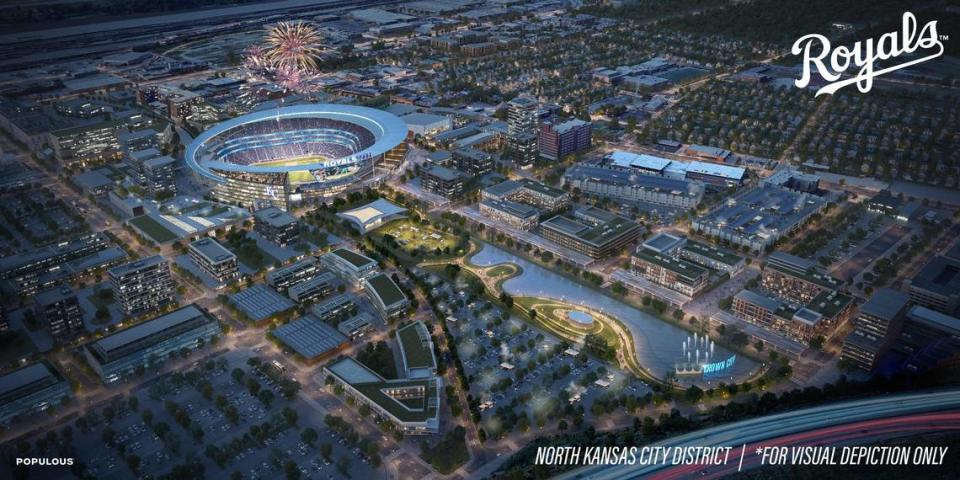Royals make stadium pitch with pictures, economic projections. Will elected leaders buy in?
- Oops!Something went wrong.Please try again later.
The Royals on Tuesday unveiled renderings of what their new baseball park might look like in either North Kansas City or downtown Kansas City’s East Village.
Along with those drawings, they announced projections showing that a new ballpark and ancillary development would boost the area economy by hundreds of millions of dollars.
But they were in no position to announce with any certainty whether either ballpark will ever be built, the team’s president for business operations, Brooks Sherman, acknowledged at the start of an hour-long news conference at their current home, Kauffman Stadium.
What Sherman called the Royals’ “generational decision” to leave their home of a half century for a new ballpark depends on the decisions of elected leaders, whose support would be necessary to put a sales tax measure on the ballot to underwrite an unspecified portion of the cost of the billion-dollar stadium the Royals envision.
“We’ve got to have those agreements with elected leaders from a public finance perspective and from a lease perspective,” Sherman said.

That would mean either an extension of the 3/8ths of a cent sales tax in Jackson County that currently goes to pay off the debt on the Truman Sports Complex and would potentially go to help pay for a new baseball stadium and renovations of Arrowhead Stadium for the Chiefs.
Or a full one-cent sales tax in Clay County for the North Kansas City site.
But those agreements are far from becoming a reality at this point, he acknowledged. Sherman and Royals Executive Vice President Sarah Tourville told reporters that the Royals continue to have conversations with Clay County Presiding Commissioner Jerry Nolte about the North Kansas City site, as well as Mayor Quinton Lucas, Jackson County Executive Frank White Jr. and county legislators about the East Village location.
“We have a good relationship with Frank White, just as we do, you know, in Clay County with Jerry Nolte,” Sherman said. “So those conversations are amicable and ongoing. I think John recently met with Frank, and we’ve seen him at the ballgame. So those are those are things that, those are negotiations that are ongoing, and we expect that to go forward.”
He was referring to team owner John Sherman, no relation to Brooks Sherman, who was not at the press event. Last week John Sherman told Star sports columnists Sam McDowell and Vahe Gregorian that despite two years of talks with White, the county executive still hasn’t promised his support of a downtown stadium at East Village
“I think we’ll get him there,” Sherman told the columnists. “I don’t know if he’s there yet.”
Indeed, he is not there yet, according to sources within county government. White remains skeptical that the East Village location will provide substantial benefits to people who live on the city’s predominantly Black East Side, where he grew up and went onto become a key member of the Royals team that won the 1985 World Series.

Team owner Sherman announced nearly two years ago his desire to have the Royals relocate to somewhere in the downtown area, accompanied by $1 billion in adjoining private real estate developments.
Sherman said the team wanted the project to benefit the community, as well as provide more revenue for the team so that it can be competitive with richer teams in Major League Baseball.
White wanted the team to consider a site on the city’s East Side near 18th and Vine streets, but the team wasn’t interested. The team, instead, preferred the East Village for its downtown location and proposes building a pedestrian bridge over Interstate 35 that would connect the East Village site with the Paseo West neighborhood, saying that will lead to East Side development.
White remains skeptical that East Side development will happen. While his support might be important from a public relations standpoint, the Royals would not need his blessing for a sales-tax measure to be put on the Jackson County ballot. A two-thirds majority of the nine-member county legislature could do that without him, as it did with regard to another, unrelated ballot issue three years ago.
Clay County became an alternative to the East Village site fairly recently. Leaders would like to have the Royals move there, but it’s unclear whether voters would support it. A recent poll of 300 Clay County voters suggested strong opposition to a tax to pay for it, with 70% saying they would be against a new sales tax “for construction of a new multibillion-dollar stadium and mixed use development.”
But Tourville said the team is confident that a ballot issue in either county would succeed, if elected leaders can be convinced to put one on the ballot.
A source within county government suspects the Royals’ announcements on Tuesday was meant to build public support for a new downtown stadium and pressure White to support the project. White declined comment.
The Royals said the renderings and economic impact numbers were merely released in furtherance of their promise to keep the public informed about where the project stands.
“We’re trying to show where we are in the process, trying to be transparent about how we’re going about making a decision,” Brooks Sherman said. “These are our two locations, we just thought that this was the right time for the transparency of both and to really show the community what could be, no matter where we go.”

